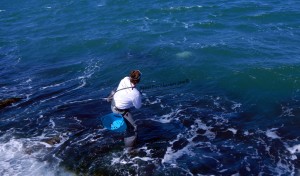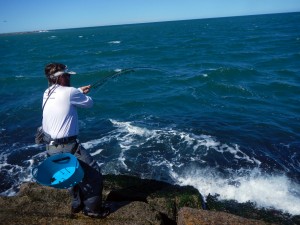… Jack be fish. Jack jumped over the fisher man.
Jackfish. Yellow bellies. Jack Crevalle. Give’em any badass name you want!
It is undeniably only a primal act of natural instinct to wait patiently perched on the tallest of rocks scanning the water while wolf packs of marauding crevelle cruise just outside of casting range on the crowded tip of a mega shrine made of red stone. Here fisherman from all sorts of watery trails convene in one place for a holy experience with a ravenous Jack.
Many are sighted and hundreds of casts thrown as offerings with a mighty heart and sometimes in faint confidence.
Then the brave soul encounters another soul of even greater brevity. It belongs to the fisherman. The best are patient. Keenly aware of their surroundings and quick to execute a precise cast and know when to retreat. That feeling, the twitch, the shake, the jitters and even the creeps, can make your hair stand on its end as if in anticipation of being jolted back to reality when the massive donkey jackfish crushes your fly out of nowhere and screams for the border. “HERE WE GO” he yells aloud!
A power and strength unrivaled in the saltwater world. Even the tightest drags and strongest of lines cannot seem to hinder the initial runs of these fish. Then, they get down and dirty and that is where you are most likely to loose. In the rocks, deep down on their flanking sides, the jack begins a process of swimming sideways and even in circles trying desperately to separate you from him. Talk about rocks being in hard places. It can end in an instant, faster than you can imagine or even react.
But with luck, a skilled angler can put maximum pressure on the fish from the instant you are hooked up together, to exerting maximum amount of turning angles on the fish when he is running from one side to the other, the techniques described below will certainly increase your odds at winning the jackfish lottery!
Fly Tech Section:
Since most saltwater fish are stronger and bigger, the butt section of the average saltwater rod is designed to do all the work. That is where your lifting power and turning capability stems from. For some people this is why they prefer fishing in saltwater over freshwater although many giants exist in sweeter waters.
Lets think about angles here for a minute, as it applies to the angle of the rod in relation to the angle of the water (horizontal) and in relation to the angle of the fish.
The most effective fish fighting method is to keep the butt section of the rod at a low angle to the water. That angle, in relation to the fish means that if the fish is moving left, your rod angle should be to your right, effectively putting pressure against the fish (from behind the fish) yet still off to its side (the fish’s left or right).
If the fish is running straight away out in front of you and you’re loosing line fast, angle the rod slightly to the left of right, but keep the butt section quite low to the water, yet keeping the vertical rod angle no higher than 45 degrees to the water. If the rod is lifted higher than 45degrees above the water (horizontal plane) when fighting a fish, the mid section of the rod has to do all the work then, and that section is not as strong as the butt section (bottom ~3ft of the rod). This prevents you from putting maximum pressure on the fish and increases the possibility of breaking the rods Gink & Gasoline wrote an article on that.
Hope you find this explanation helpful and with little effort and patience the mighty Jack will pay you a certain visit you cannot forget.
Until next time, sharpen your hooks and I will work to put together a video on preferred knots to connect the fly, and to connect leaders with bite tippets.
-Captain Kenjo, Port Aransas, Texas

